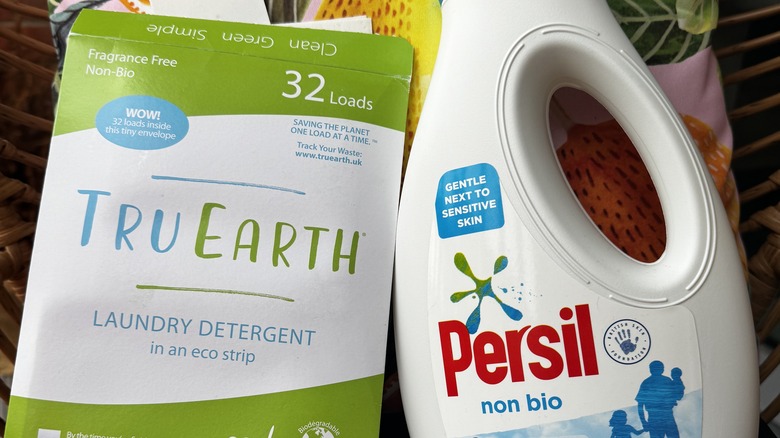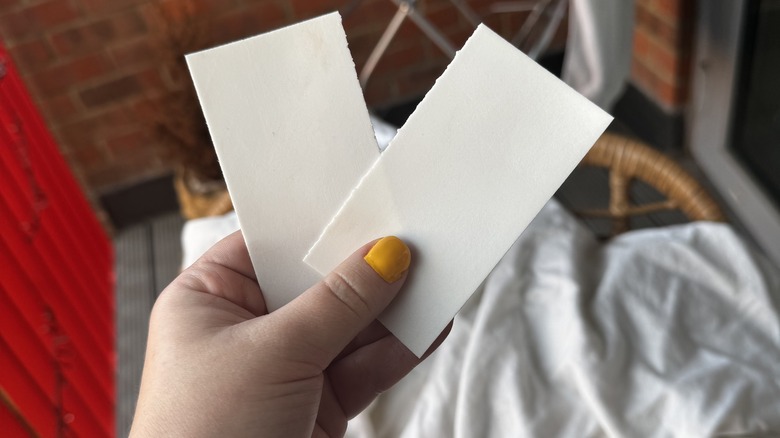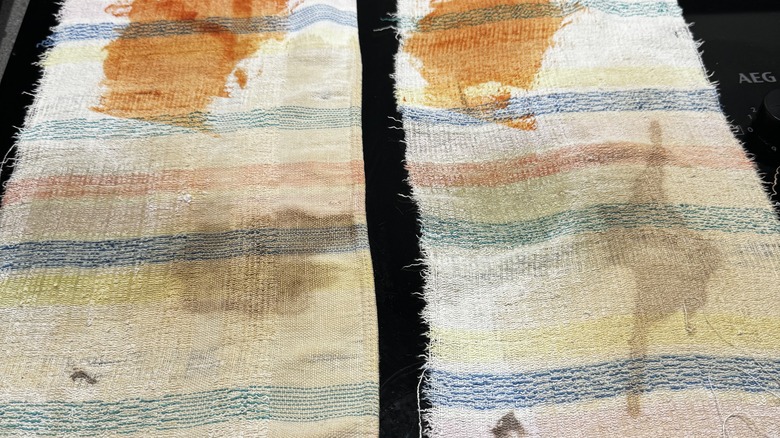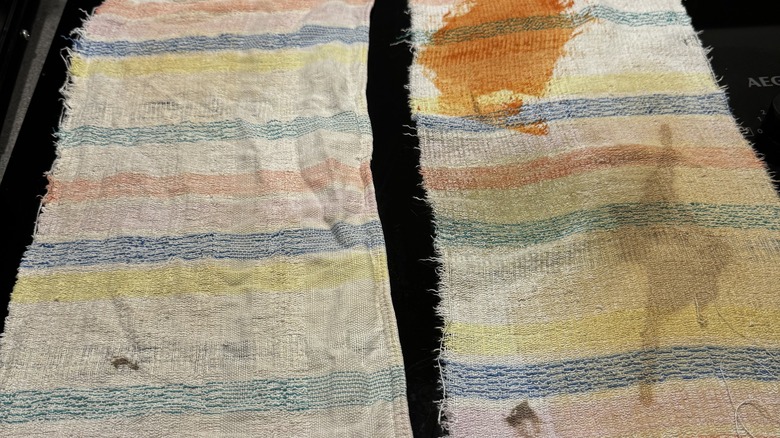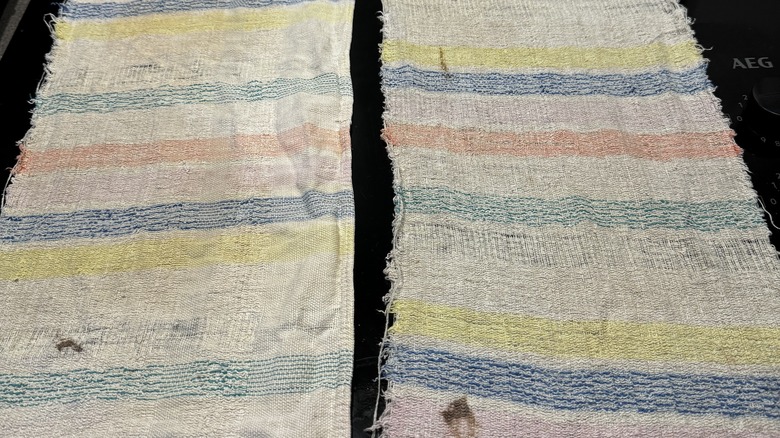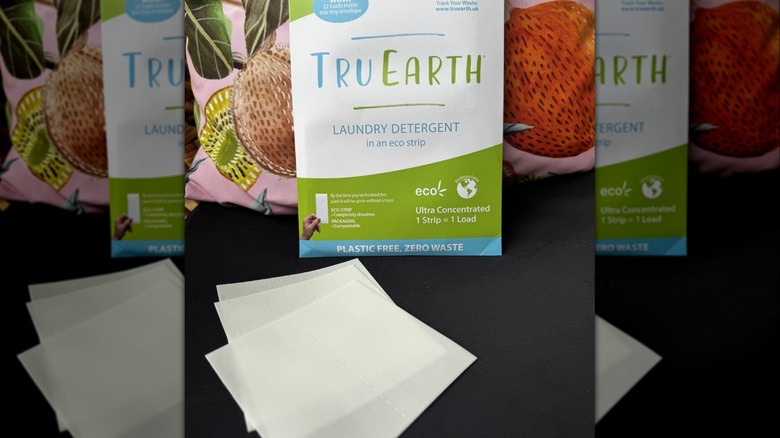We Compared Tru Earth Laundry Strips To A Liquid Detergent With Stain-Lifting Results
We may receive a commission on purchases made from links.
I am always looking to make eco-friendly changes to my laundry routine, especially when it comes to my detergent. There are loads of cleaning products out there that promise to be just as effective as conventional liquid and powder detergents, but with less chemicals, and often with more eco-conscious packaging. So, I was all too eager to try out Tru Earth's laundry strips and put them to the test against a regular liquid detergent.
Tru Earth's laundry strips offer several benefits. Because they come as dry strips, they are extremely lightweight and easy to ship, which is great for reducing the carbon footprint during the manufacturing and shipping process. They also come in a simple cardboard box, meaning no plastic is involved — a huge win for keeping non-recyclable materials out of landfills. This packaging also means they are easy to store just about anywhere, saving you room on top of your washing machine. As they are thin sheets not containing any liquid, they are considered an undiluted, concentrated form of detergent that the brand claims can pack a ton of cleaning power. Those with sensitive skin will also be pleased to hear that Tru Earth's strips are hypoallergenic and don't contain parabens, enzymes, or dyes. But, can they stand up to traditional laundry detergents?
What ingredients are in Tru Earth laundry strips
The Tru Earth laundry strips don't contain ingredients that are substantially different from mainstream detergents, unlike other eco-friendly laundry products like the EcoEgg. The strips consists of various hard-to-spell surfactants, solvents, and preservatives. One of its major selling points, though, is what Tru Earth chooses to leave out — Tru Earth boasts a phosphate-free formula. Phosphates are often added to detergents as a water softener, but they are known to cause skin and eye irritation in some individuals, and there are some environmental concerns about phosphates, as an excess can pollute water sources and deplete the nutrients found in soil. So, the exclusion of phosphates sets this detergent apart, and may be a bonus for the eco-conscious or those with sensitive skin. I purchased a pack of 32 unscented Tru Earth strips from Amazon UK for £13.99, and the product can also be obtained in the U.S. from Amazon for under $20 (though they're often on sale for less). A 32-pack is labeled as enough for 32 full washes, but Tru Earth provides perforated, tearable sheets that you could split into 64 small loads.
To test the effectiveness of these liquidless detergent sheets, I needed to compare them to a more classic-style detergent. I chose Persil Non-Bio liquid detergent, which was available at my local market. As a note, Persil Non-Bio does include phosphates in the form of phosphonates. I bought a 945 milliliter bottle that was labeled to be enough for 35 washes for £7.00, which converts to roughly $9.00.
Putting Tru Earth laundry strips to the test
I planned to do one load of laundry per detergent and compare results. But, I realized this could be complicated to qualify, since some loads may have more heavily soiled fabrics like my dish towels. To make it fair for both detergents, I cut an old dish rag that had already suffered from irremovable stains, thanks to an at-home eyebrow tinting experiment. I wanted to test the detergents on some of the most common and toughest laundry stains, so I gave each fabric piece a healthy splash of olive oil, coffee, and ketchup. I allowed the two to soak up these stains for a few hours, so they had plenty of time to dry and really set in to make this a proper challenge.
Additionally, I decided to run both loads on the same cycle type for the same amount of time: a 1-hour wash cycle for cottons at 60 degrees Celsius (140 degrees Fahrenheit). I did load the two rag halves with my regular laundry, so as to not waste water and product, so each got the treatment with a standard sized load. Accordingly, I used a full sheet of the Tru Earth detergent, which I placed directly in the tumbler, and the recommended 27 milliliters of the Persil liquid detergent in the detergent drawer. I did add a dash of fabric softener to each load to add some fragrance and combat London's extremely hard water.
Tru Earth laundry strip results
I was excited to see the Tru Earth results, so I trialed this detergent first. When the cycle was done, I fished out the torn dish rag and fully expected it to be partially stained. I was stunned to see all of the stains completely lifted, aside from the brown-grey eyebrow tint marks, which I did not expect household detergent could remove. Not only had the ketchup, coffee, and oil stains been eradicated, but I swear the whites and the colorful stripes of the rag looked brighter as well.
In this load of laundry, I also washed a fitted sheet, two pillowcases, and a bath sheet. The sheets and pillowcases came out pristine, and what stood out most to me was how soft they were. I also noticed as I hung them to dry that they had far fewer wrinkles than I'm used to. I am sure the fabric softener helped with this, but I use the same softener every time I do laundry, and still believe the Tru Earth strips made a tangible, visible difference in conditioning these fabrics. My bath sheet did still have a mark or two from smeared mascara, but overall it looked and felt very clean. There was also no sticky or powdery soap residue feeling on any of the items, which I was worried about, since I used a full strip.
Tru Earth versus traditional detergent
I washed the other half of the dish rag along with a few blouses and leggings, which was very similar in size as the previous load. Once the cycle was complete, I fished the rag out and was again very happily surprised to see the food stains had all lifted from the fabric and left no trace. The rest of the clothes in this load were left stain-free as well, though none of them were heavily stained to begin with. Both detergents delivered really well at stain-removing, but one product surpassed expectations.
The Tru Earth laundry strips came out ahead in this test, because I didn't just look for stain removal — which both brands dealt with impressively. When placed side-by-side, I saw that the dish rag washed with traditional detergent has a noticeably grayer, dull tinge. The rag washed with the Tru Earth strips looked considerably brighter and refreshed. It's also worth noting that both rags were treated with the same amount of fabric softener, and the Tru Earth side was considerably softer to the touch. Overall, I found that Tru Earth detergent was the superior choice here.
Are Tru Earth laundry strips worth it?
So, would I buy Tru Earth laundry strips again? The cleaning power is clear, but that's not the only factor to consider. One thing about using the laundry strips instead of a heavy jug of liquid detergent or a bucket of powder is that it feels like you aren't getting much for your money. I decided to run the numbers to see if that was true. Tru Earth runs $19.95 for 32 laundry strips, so the cost-per-load of these strips comes to approximately $0.62 per load. The 945 milliliter Persil detergent clocks in at about $0.25 per load. At about $0.37 more per wash, Tru Earth is more expensive, and that can add up over time.
I am curious if splitting the sheets in half would provide enough cleaning power as the box states it can, as this would cut costs, and I will definitely be testing this in future loads. These laundry cycle experiments were also washed with warm water, and though the brand says the strips dissolve in cold water as well, I look forward to trying that for myself. But, as it currently stands, I am very impressed with how Tru Earth's strips performed and would recommend them to folks looking for a powerful, eco-friendly laundry detergent.
